
By Chris Mah - Smithsonian Institution’s National Museum of Natural History
June 24, 2016
As a specialist in the biology, ecology, and diversity of deep-sea sea stars, also known as starfish or asteroids, I participate in Okeanos Explorer expeditions as a member of the shore-side science team. As of this writing, I have described over two dozen new species of asteroids, many of which we have encountered on this cruise.
Okeanos Explorer expeditions provide us with a unique opportunity to observe deep-sea sea stars in their natural habitat. Sea stars are familiar to most people, but because deep-sea animals are adapted to such unusual environments, even well-known kinds of animals (e.g., crabs, etc.) can appear alien in the deep-sea. Historically, collection of deep-sea sea stars has been via dredge or trawl nets, which doesn’t provide a good idea of habitat and often obscures the natural life mode of many of these animals.
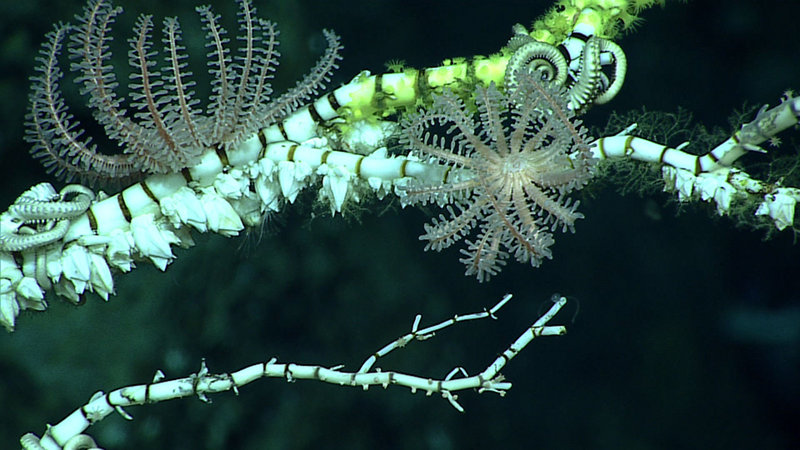
An example of how observing LIVE sea stars differs significantly from trawled specimens can be seen in brisingid sea stars. Brisingids have been seen on almost every Okeanos Explorer cruise I have participated in. This group of sea star lives exclusively in the deep-sea (> 200 meters and down to 6,000 meters). They extend their arms up into the water column to capture food. This type of sea star also has spines covered by pedicellariae (small wrench- or claw-shaped appendages). The one shown here is Novodinia, and it is taking advantage of its perch on this dead bamboo coral branch to feed on crustaceans being carried by in the current. Image courtesy of NOAA Office of Ocean Exploration and Research, 2016 Deepwater Exploration of the Marianas. Download larger version (jpg, 790 KB).
Above is an example of how observing LIVE sea stars differs significantly from trawled specimens can be seen in brisingid sea stars. Brisingids have been seen on almost every Okeanos Explorer cruise I have participated in. This group of sea star lives exclusively in the deep-sea (> 200 meters and down to 6,000 meters). They extend their arms up into the water column to capture food. This type of sea star also has spines covered by pedicellariae (small wrench- or claw-shaped appendages). The one shown above is Novodinia, and it is taking advantage of its perch on this dead bamboo coral branch to feed on crustaceans being carried by in the current.
However, prior to submersible observations in the 1970s, the feeding posture you see above was unknown. It was postulated in the late 19th Century that brisingids dragged their long and spindly arms across the seafloor, catching food on their long spines in a manner similar to some of the trawls that humans used to sample the deep ocean at the time.
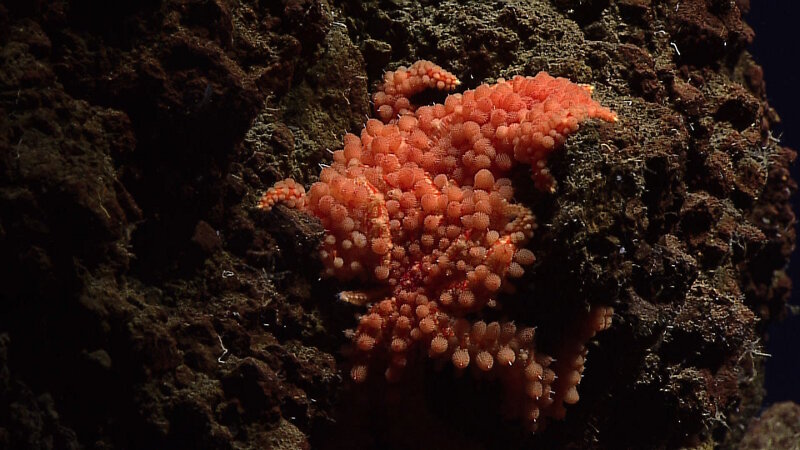
The weird red jumble featured in this image was so “UN-starfish like” that even a room full of my experienced colleagues were uncertain what it was at first! Although, it didn’t look like one, this is a deep-sea star in the genus Coronaster. This is a multi-armed starfish with a flexible body that was sort of folded back onto itself into this crack on the deep-sea floor. Image courtesy of NOAA Office of Ocean Exploration and Research, 2016 Deepwater Exploration of the Marianas. Download larger version (jpg, 869 KB).
The weird red jumble featured in the image above was so “UN-starfish like” that even a room full of my experienced colleagues were uncertain what it was at first! Although, it didn’t look like one, this is a deep-sea star in the genus Coronaster. This is a multi-armed starfish with a flexible body that was sort of folded back onto itself into this crack on the deep-sea floor.
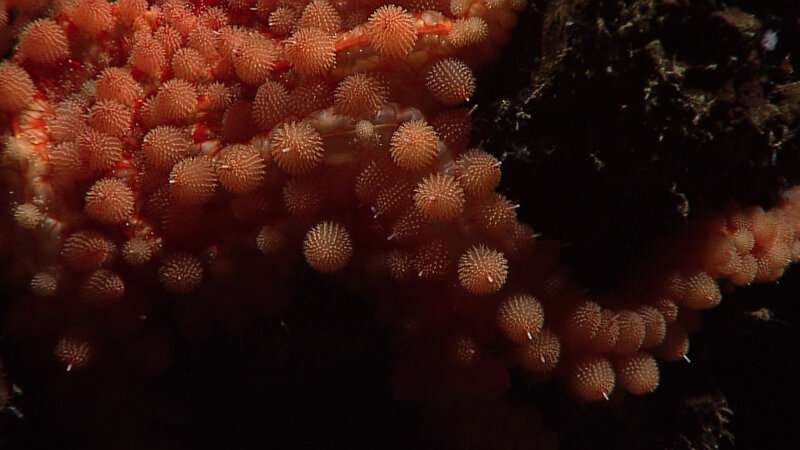
In this image, all of the round structures on the surface are actually spines. Each one of these spines carries a big ball of bear trap-like claws called pedicellariae which can be used to defend the organism or to feed on prey. Most times these animals have been observed they have been splayed out on the ocean floor- I’ve never observed one tucked into a crevice like this before. The way that this animal has its main disk and arms tucked away with spines and defensive batteries extended is consistent with this species’ soft and elongate arms. Image courtesy of NOAA Office of Ocean Exploration and Research, 2016 Deepwater Exploration of the Marianas. Download larger version (jpg, 604 KB).
In the image above, all of the round structures on the surface are actually spines. Each one of these spines carries a big ball of bear trap-like claws called pedicellariae which can be used to defend the organism or to feed on prey. Most times these animals have been observed they have been splayed out on the ocean floor- I’ve never observed one tucked into a crevice like this before. The way that this animal has its main disk and arms tucked away with spines and defensive batteries extended is consistent with this species’ soft and elongate arms.
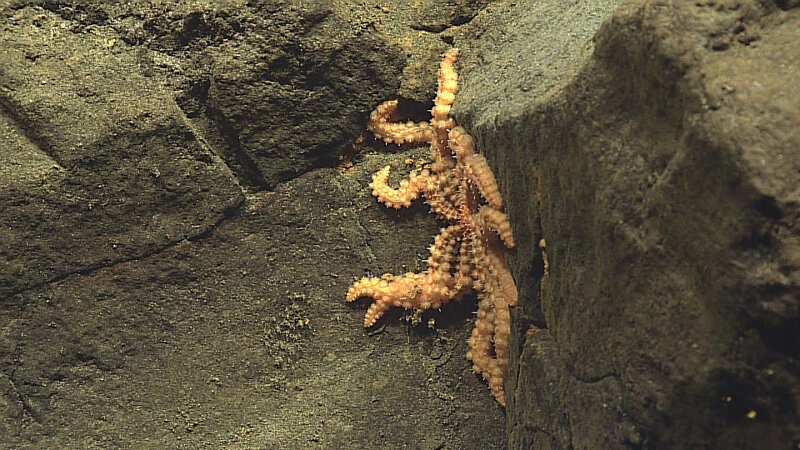
Here’s a multi-armed sea star that we saw later that showed how they “normally” look, with the arms extended away from the oral disk. However, prior to submersible observations in the 1970s, the feeding posture you see here was unknown. It was postulated in the late 19th Century that brisingids dragged their long and spindly arms across the seafloor, catching food on their long spines in a manner similar to some of the trawls that humans used to sample the deep ocean at the time. Image courtesy of NOAA Office of Ocean Exploration and Research, 2016 Deepwater Exploration of the Marianas. Download larger version (jpg, 1.1 MB).
The image above features a multi-armed sea star we saw later that showed how they “normally” look, with the arms extended away from the oral disk.
Nonetheless, video and in situ observations can only take us so far. Sometimes we see things that we only know due to our prior knowledge of examined specimens. And knowing more requires actual examination.
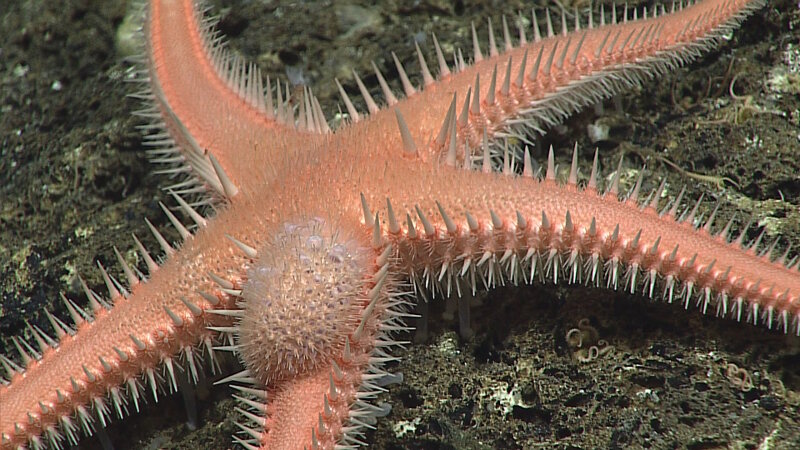
For example, here is a deep-sea asteroid called Cheiraster sp. (in the family Benthopectinidae). That large round ball-shaped bulge on the arm is actually an extension from the INSIDE of the body because the sea star has been infected by what is most likely a parasitic barnacle. These barnacles are different from the ones that most people encounter. They lack the familiar external plates and are instead very soft-bodied. Their larvae enter into the starfish body cavity and begin to grow, taking advantage of the host animal’s nutrients and sometimes their reproductive systems. The parasites can produce thousands of eggs, likely generated at the expense of the host. Image courtesy of NOAA Office of Ocean Exploration and Research, 2016 Deepwater Exploration of the Marianas. Download larger version (jpg, 1.0 MB).
For example, in the image above, a deep-sea asteroid called Cheiraster sp. (in the family Benthopectinidae). That large round ball-shaped bulge on the arm is actually an extension from the INSIDE of the body because the sea star has been infected by what is most likely a parasitic barnacle. These barnacles are different from the ones that most people encounter. They lack the familiar external plates and are instead very soft-bodied. Their larvae enter into the starfish body cavity and begin to grow, taking advantage of the host animal’s nutrients and sometimes their reproductive systems. The parasites can produce thousands of eggs, likely generated at the expense of the host.
It may surprise most people that as familiar as sea stars are, there are surprisingly large gaps in our knowledge regarding the basic biology and especially ecology of most described species, especially those in the deep-sea. Our ongoing exploration of the oceans will be essential in understanding the crucial ecological role of sea stars as we come to better understand deep-sea and other marine ecosystems.